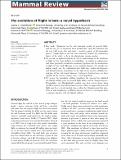The evolution of flight in bats : a novel hypothesis
Abstract
1. Bats (order Chiroptera) are the only mammals capable of powered flight, and this may be an important factor behind their rapid diversification into the over 1400 species that exist today – around a quarter of all mammalian species. Though flight in bats has been extensively studied, the evolutionary history of the ability to fly in the chiropterans remains unclear. 2. We provide an updated synthesis of current understanding of the mechanics of flight in bats (from skeleton to metabolism), its relation to echolocation, and where previously articulated evolutionary hypotheses for the development of flight in bats stand following recent empirical advances. We consider the gliding model, and the echolocation‐first, flight‐first, tandem development, and diurnal frugivore hypotheses. In the light of the recently published description of the web‐winged dinosaur Ambopteryx longibrachium, we draw together all the current evidence into a novel hypothesis. 3. We present the interdigital webbing hypothesis: the ancestral bat exhibited interdigital webbing prior to powered flight ability, and the Yangochiroptera, Pteropodidae, and Rhinolophoidea evolved into their current forms along parallel trajectories from this common ancestor. Thus, we suggest that powered flight may have evolved multiple times within the Chiroptera and that similarity in wing morphology in different lineages is driven by convergence from a common ancestor with interdigital webbing.
Citation
Anderson , S & Ruxton , G D 2020 , ' The evolution of flight in bats : a novel hypothesis ' , Mammal Review , vol. 50 , no. 4 , pp. 426-439 . https://doi.org/10.1111/mam.12211
Publication
Mammal Review
Status
Peer reviewed
ISSN
0305-1838Type
Journal item
Collections
Items in the St Andrews Research Repository are protected by copyright, with all rights reserved, unless otherwise indicated.

